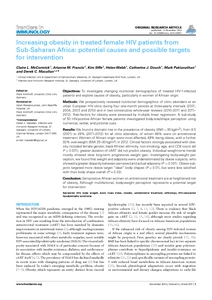McCormick, CL; Francis, AM; Iliffe, K; Webb, H; Douch, CJ; Pakianathan, M; Macallan, DC
(2014)
Increasing Obesity in Treated Female HIV Patients from Sub-Saharan Africa: Potential Causes and Possible Targets for Intervention.
Frontiers in Immunology, 5 (507).
ISSN 1664-3224
https://doi.org/10.3389/fimmu.2014.00507
SGUL Authors: Macallan, Derek Clive
![[img]](https://openaccess.sgul.ac.uk/107257/1.hassmallThumbnailVersion/Increasing_obesity_female_HIV_patients.pdf)  Preview |
|
["document_typename_application/pdf; charset=binary" not defined]
Published Version
Download (505kB)
| Preview
|
Abstract
Objectives: To investigate changing nutritional demographics of treated HIV-1-infected patients and explore causes of obesity, particularly in women of African origin.
Methods: We prospectively reviewed nutritional demographics of clinic attenders at an urban European HIV clinic during four one-month periods at three-yearly intervals (2001, 2004, 2007, and 2010) and in two consecutive whole-year reviews (2010-2011 and 2011-2012). Risk-factors for obesity were assessed by multiple linear regression. A sub-study of 50 HIV-positive African female patients investigated body-size/shape perception using numerical, verbal, and pictorial cues.
Results: We found a dramatic rise in the prevalence of obesity (BMI > 30 kg/m(2)), from 8.5 (2001) to 28% (2011-2012) for all clinic attenders, of whom 86% were on antiretroviral treatment. Women of African origin were most affected, 49% being obese, with a further 32% overweight (BMI 25-30 kg/m(2)) in 2012. Clinical factors strongly associated with obesity included female gender, black African ethnicity, non-smoking, age, and CD4 count (all P < 0.001); greater duration of cART did not predict obesity. Individual weight-time trends mostly showed slow long-term progressive weight gain. Investigating body-weight perception, we found that weight and adiposity were underestimated by obese subjects, who showed a greater disparity between perceived and actual adiposity (P < 0.001). Obese subjects targeted more obese target "ideal" body shapes (P < 0.01), but were less satisfied with their body shape overall (P = 0.02).
Conclusion: Seropositive African women on antiretroviral treatment are at heightened risk of obesity. Although multifactorial, body-weight perception represents a potential target for intervention.
| Item Type: |
Article
|
| Additional Information: |
© 2014 McCormick, Francis, Iliffe, Webb, Douch, Pakianathan and Macallan. This is an open-access article distributed under the terms of the Creative Commons Attribution License (CC BY). The use, distribution or reproduction in other forums is permitted, provided the original author(s) or licensor are credited and that the original publication in this journal is cited, in accordance with accepted academic practice. No use, distribution or reproduction is permitted which does not comply with these terms. |
| Keywords: |
HIV, HIV-associated lipodystrophy syndrome, antiretroviral treatment, body mass index, body weight, ethnology, obesity |
| SGUL Research Institute / Research Centre: |
Academic Structure > Infection and Immunity Research Institute (INII) |
| Journal or Publication Title: |
Frontiers in Immunology |
| ISSN: |
1664-3224 |
| Language: |
ENG |
| Dates: |
| Date | Event |
|---|
| 13 November 2014 | Published |
|
| PubMed ID: |
25431572 |
 |
Go to PubMed abstract |
| URI: |
https://openaccess.sgul.ac.uk/id/eprint/107257 |
| Publisher's version: |
https://doi.org/10.3389/fimmu.2014.00507 |
Statistics
Item downloaded times since 20 Jan 2015.
Actions (login required)
 |
Edit Item |



